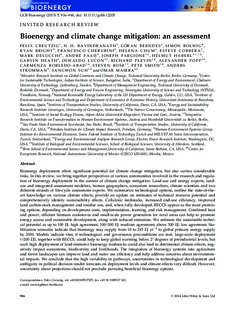| dc.description.abstract | Bioenergy deployment offers significant potential for climate change mitigation, but also carries considerable
risks. In this review, we bring together perspectives of various communities involved in the research and regulation of bioenergy deployment in the context of climate change mitigation: Land-use and energy experts, landuse and integrated assessment modelers, human geographers, ecosystem researchers, climate scientists and two
different strands of life-cycle assessment experts. We summarize technological options, outline the state-of-theart knowledge on various climate effects, provide an update on estimates of technical resource potential and
comprehensively identify sustainability effects. Cellulosic feedstocks, increased end-use efficiency, improved
land carbon-stock management and residue use, and, when fully developed, BECCS appear as the most promising options, depending on development costs, implementation, learning, and risk management. Combined heat
and power, efficient biomass cookstoves and small-scale power generation for rural areas can help to promote
energy access and sustainable development, along with reduced emissions. We estimate the sustainable technical potential as up to 100 EJ: high agreement; 100–300 EJ: medium agreement; above 300 EJ: low agreement. Stabilization scenarios indicate that bioenergy may supply from 10 to 245 EJ yr 1 to global primary energy supply
by 2050. Models indicate that, if technological and governance preconditions are met, large-scale deployment
(>200 EJ), together with BECCS, could help to keep global warming below 2° degrees of preindustrial levels; but
such high deployment of land-intensive bioenergy feedstocks could also lead to detrimental climate effects, negatively impact ecosystems, biodiversity and livelihoods. The integration of bioenergy systems into agriculture
and forest landscapes can improve land and water use efficiency and help address concerns about environmental impacts. We conclude that the high variability in pathways, uncertainties in technological development and
ambiguity in political decision render forecasts on deployment levels and climate effects very difficult. However,
uncertainty about projections should not preclude pursuing beneficial bioenergy options. | nb_NO |

